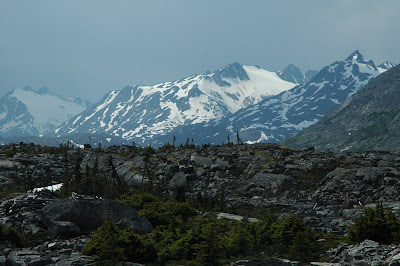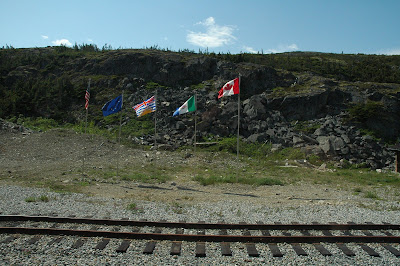We only had a quick overnight in Juneau and left for Skagway on Friday, July 3. This leg of the journey was on the Malaspinia. This vessel was the first ferry built when the Alaska Marine Highway was developed in 1963. Each boat we have been on has a different personality. Our favorite so far has been the Fairweather, but they are all well maintained, with similar amenities, and friendly crew.

The ferry arrived in Skagway about 10:30 PM. We located the campground and got set up just in time to see the 11:00 town fireworks through the trees surrounding our campsite. We also missed the street dance, which we heard was quite an event. The next day, however, there were “events” all day. This Fourth of July celebration began at 9 AM with a road race, and continued with activities all day, until the Duck Derby at 5:00.
The list of fun events included a dessert auction, foot races for various age groups, a kids carnival, a tug of war, arm wrestling, horseshoe tournament, a railroad spike driving contest, a slow bike race, and my favorite, a two block long line for the egg toss. Last year the town captured the Guinness Book of World Records title for the most people in an egg toss. They mustered 1163-recorded people and took the honors away from another Southeastern Alaska town called Wrangell.
 Steam Engine 73 all decked out for the fourth of July. I took this from our camper
Steam Engine 73 all decked out for the fourth of July. I took this from our camper
This was a 100 yard dash for women over 40. Since I was WAY over 40, I joined in. (I did not come in last)
 Raising the flag in honor of Alaska's 50th Birthday
Raising the flag in honor of Alaska's 50th Birthday
 Gettting set up along the two city blocks for the egg toss (You can tell I really liked this event)
Gettting set up along the two city blocks for the egg toss (You can tell I really liked this event)



 He did it
He did it oops
oopsSkagway is noted for its part in the gold rush of 1897-1898. Although the gold fields were about 600 miles away from this inside passage port, it was the gateway to the White Horse pass and the nearby Chilkoot Pass which left from the city of nearby Dyea. These two passes were the preferred jumping off locations on the tortuous journey to the Klondike, where the gold was found.
Would be miners sailed from California and Washington into Skagway, where they had to pull together one ton, a years supply, of provisions and equipment before they would be allowed to cross the boundary into the Yukon. This situation created a natural breeding spot for crooks and swindlers, one of the most famous being a man called Jeff “Soapy” Smith.
During a lull in the fourth activities, we scooted in to see a locally presented play called The Days of 98 Show. This light hearted spoof takes place in “Jeff Smith’s Parlor” where whiskey and dance hall girls are only one of the places a miner could loose their money to Soapy and his gang. The play does not make light of Soapy’s villainous ways, but points out some of the few good deeds he did for busted miners after his operation had swindled them out of all they had. Lots of singing, dancing and audience participation, (volunteered or not).


 the can can dance
the can can dance
The "slow" bike race for women
 and men
and menThe two trails into the Klondike Gold Fields, the White Pass and the Chilkoot, were both treacherous, dangerous treks over the coastal mountains. The Chilkoot was steeper and shorter than the White Pass. No matter which choice the tens of thousands of gold crazy men and women who braved the trip made, they had to bring with them, over these mountains, one ton of provisions, enough to last them a year.
During 1897 and 1898 several creative means to profit from moving these goods were invented. They ranged from simply hiring Native packers to carry provisions, using horses and mules, to the construction of an overhead tram. The White Pass railroad was the most ambitions and in the end it became the only method used to get over the pass. Construction of this rail line began in July of 1898 and the 110 miles of track was completed in July of 1899. Unfortunately, the gold rush was over within another year.
There are unbelievable tales and photos to be seen chronicling this piece of Klondike Gold Rush history. I could not begin to tell the story. If you are interested in the history The National Park Service has a web site at www.nps.gov/klgo
Sunday morning we had tickets for a ride on the very same White Pass and Yukon narrow gage railroad that was pulled by an old steam locomotive number 73. The trip seemed almost too much for the train, I cannot imagine trekking over this pass with a 100 pound pack on my back, walking over snow covered rocks.
After passing the summit at 2,650 feet, our train turned around at Frazer Meadow. The miners still had to travel on till they reached the Yukon River, where they had to build a boat to continue on another 560 miles before reaching the gold fields. The scenery was magnificent and the whole trip I kept thinking about those prospectors trudging through the pass in the middle of winter. Ugh.


















No comments:
Post a Comment